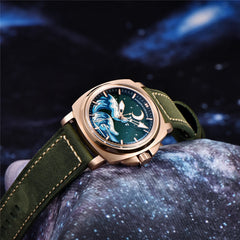What is a GMT watch and how does it work?
The GMT function is a very useful complication, especially for those who travel frequently, as it allows quick reference to both the time of the place being visited and the time of the place of origin.
What does GMT time mean?

HOW CAN YOU TELL IF A WATCH IS A GMT?
HOW TO USE THE GMT FUNCTION?
The dial of standard wristwatches generally measures a 12-hour time interval. This means the hour hand makes two full rotations around the dial within 24 hours. To indicate GMT, the watch has an additional hour hand, typically arrow-shaped and a different color from the 12-hour hand. Unlike the hour hand, the GMT hand takes 24 hours to complete a full rotation around the dial, so its speed is half that of the other hand. The GMT time is read through the 24-hour bezel.
Besides their aesthetic appeal, GMT watches are especially practical for those who travel abroad. Thus, a person traveling from Frankfurt to Sydney will have to continuously remember that the time difference compared to local German time is 8 hours and, therefore, when arriving in Australia, will always have to calculate the time based on German time. This becomes even more complicated if that person also has relatives in New York. In this way, a GMT watch will help avoid these types of problems very easily.
But let's see concretely with this example how to use the GMT function on a watch that separately includes an adjustable hour hand.
You can set the different time zones at any time, whether still at home or once landed in Sydney at 8:00 PM. You simply need to set the GMT hands on the dial to European time (12:00). Then, also adjust the hour hand to Sydney local time (8:00 PM). To set New York time, move the 24-hour bezel (GMT hand) to the corresponding time of that city (6:00). With these brief and simple steps, you will now have three time zones simultaneously.



